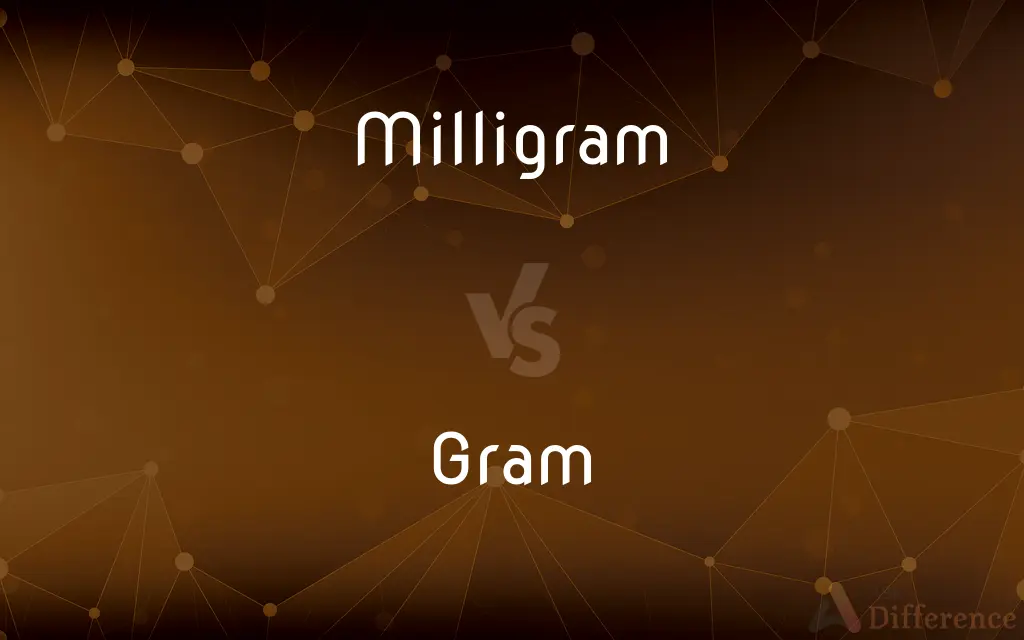Milligram vs. Gram — What's the Difference?
By Tayyaba Rehman & Urooj Arif — Updated on May 3, 2024
Milligrams and grams are units of mass in the metric system, with one gram equaling 1,000 milligrams.

Difference Between Milligram and Gram
Table of Contents
ADVERTISEMENT
Key Differences
A milligram is a unit of mass in the metric system that represents one thousandth of a gram, whereas a gram is a basic unit of mass in the same system. Milligrams are used when dealing with very light or precise measurements, such as in medicine or chemistry, while grams are more commonly used in everyday situations like cooking or grocery shopping.
Milligrams are crucial in contexts where precision is key, such as dosing medication, whereas grams are sufficient for less precise needs, like measuring ingredients. In scientific research, the accuracy provided by milligrams can be essential, on the other hand, in casual cooking, grams provide enough precision.
Nutritional information is often given in grams, but when it comes to ingredients that are effective in smaller quantities, such as vitamins or minerals, milligrams are used. This highlights the importance of milligrams for detailed dietary tracking, while grams are typically used for broader measurements of macronutrients like proteins, fats, and carbohydrates.
Comparison Chart
Definition
A unit of mass equal to 0.001 grams.
A unit of mass in the metric system.
Common Uses
Medication dosing, scientific measurements.
Cooking, grocery shopping, body weight.
ADVERTISEMENT
Measurement Type
Extremely precise, for small quantities.
Less precise, suitable for common usage.
Importance
Essential in pharmacology and chemistry.
Common in everyday life and basic science.
Example
"The dosage is 500 milligrams."
"The recipe needs 200 grams of sugar."
Compare with Definitions
Milligram
Essential in laboratory settings for accurate measurements.
The laboratory test used 15 milligrams of the sample.
Gram
Used in commerce for pricing items by weight.
The apples cost $2 per gram.
Milligram
Common in nutrition labels for micro-ingredients.
This cereal contains 100 milligrams of calcium per serving.
Gram
A common unit of mass used daily around the world.
He added 500 grams of flour to the mixture.
Milligram
A very small unit of mass in the metric system.
The patient was prescribed 250 milligrams of the medication.
Gram
Basic scientific unit for mass in the metric system.
The compound weighed 20 grams.
Milligram
Used for precise scientific calculations.
The chemical reaction required just 10 milligrams of the substance.
Gram
Often used in culinary recipes for measuring ingredients.
The recipe required 150 grams of butter.
Milligram
Important in environmental science measurements.
The air pollution was measured at 30 milligrams per cubic meter.
Gram
Important for measuring body weight in animals and humans.
The newborn puppy weighed 300 grams.
Milligram
A unit of mass equal to one thousandth (10-3) of a gram. See Table at measurement.
Gram
The gram (alternative spelling: gramme; SI unit symbol: g) is a metric system unit of mass. Originally defined as "the absolute weight of a volume of pure water equal to the cube of the hundredth part of a metre [1 cm3], and at the temperature of melting ice" (later at 4 °C, the temperature of maximum density of water).
Milligram
An SI unit of mass, equivalent to one thousandth of a gram. Symbol: mg
Gram
A metric unit of mass equal to one thousandth (10-3) of a kilogram. See Table at measurement.
Milligram
A measure of weight, in the metric system, being the thousandth part of a gram, equal to the weight of a cubic millimeter of water, or .01543 of a grain avoirdupois.
Gram
Any of several legumes, such as the chickpea, bearing seeds used as food.
Milligram
One thousandth (1/1,000) gram
Gram
The seeds of such a plant.
Gram
A grandmother.
Gram
A unit of mass equal to one-thousandth of a kilogram. Symbol: g.
Gram
A leguminous plant grown for its seeds, especially the chickpea.
Gram
(uncountable) The seeds of these plants.
Gram
Grandmother.
Gram
(US) graham
Gram
(colloquial) 'gram
Gram
Angry.
Gram
The East Indian name of the chick-pea (Cicer arietinum) and its seeds; also, other similar seeds there used for food.
Gram
A metric unit of weight equal to one thousandth of a kilogram
Gram
Danish physician and bacteriologist who developed a method of staining bacteria to distinguish among them (1853-1938)
Common Curiosities
What are typical items weighed in grams?
Food products, postal items, and small objects.
What is heavier, a milligram or a gram?
A gram is heavier; it equals 1,000 milligrams.
What is a practical example of a milligram measurement?
Measuring the active ingredient in a pill.
Can you convert milligrams to grams?
Yes, to convert milligrams to grams, divide by 1,000.
How do milligrams relate to kilograms?
There are 1,000,000 milligrams in a kilogram.
Why might a scientist use milligrams instead of grams?
For greater precision in experimental measurements.
What role do grams play in nutrition?
They are used to measure macronutrient content in foods.
Why are milligrams important in medicine?
They allow for precise dosage measurements, crucial for safety and effectiveness.
What everyday items are measured in grams?
Most food items and grocery products.
How does the precision of milligrams benefit scientific research?
It ensures accuracy in chemical compositions and reactions.
Are milligrams used in sports?
Yes, particularly in measuring amounts of supplements or drugs.
Share Your Discovery

Previous Comparison
Resin vs. Plastic
Next Comparison
Baptist vs. AnabaptistAuthor Spotlight
Written by
Tayyaba RehmanTayyaba Rehman is a distinguished writer, currently serving as a primary contributor to askdifference.com. As a researcher in semantics and etymology, Tayyaba's passion for the complexity of languages and their distinctions has found a perfect home on the platform. Tayyaba delves into the intricacies of language, distinguishing between commonly confused words and phrases, thereby providing clarity for readers worldwide.
Co-written by
Urooj ArifUrooj is a skilled content writer at Ask Difference, known for her exceptional ability to simplify complex topics into engaging and informative content. With a passion for research and a flair for clear, concise writing, she consistently delivers articles that resonate with our diverse audience.













































